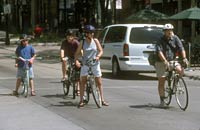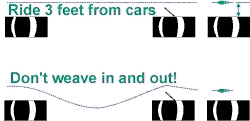General rules | Narrow lanes | Wide lanes | Doors | Take the lane | How to ride | Motorist reminders

General rules
- Ride at least three feet from the curb or parked vehicles or debris in curb area and in a straight line. Don't swerve in and out around parked vehicles.
- Always ride in the same direction as traffic.
- Sidewalk riding for bicyclists past the learning stage and being closely supervised by adults can be more dangerous than on the road, obeying traffic laws. It is also illegal unless the community has passed an ordinance specifically permitting sidewalk riding. This can be age-restricted, location-restricted or based on the type of property abutting the sidewalk.
- Obey all traffic laws.
- Be predictable! Let other users know where you intend to go and maintain an understood course.
Narrow lanes
- Ride in the center of the lane.
- Keep at least three feet between yourself and passing or parked traffic.

Wide lanes
- Ride just to the right of the actual traffic line, not alongside the curb.
- Keep at least three feet between yourself and the curb or from parked vehicles. Motorists should be passing you with at least 3 feet of clearance.

Don't get the door prize!
- Ride in a straight line three feet out from parked cars. You'll avoid car doors that open in front of you and you'll be more visible to other drivers.
- Don't pull into the space between parked cars. Ride just to the right of the actual traffic line, not alongside the curb.
- Ride straight, three feet from parked cars - don't get "doored"

Take the lane
You will fare better with other road users if you function like a legal vehicle operator, which you are.
-
Right turning motorists can be a problem, but taking the lane or more of the right portion of the wide curb lane can prevent this. Take an adult bicycling course to learn skills and develop confidence in traffic.
-
Left turning motorists are the cause of most adult bicyclists’ crashes. Motorists claim not to see the cyclist who is traveling in a straight path in the opposite direction.
Bicyclists, when making your own left turn look over your left shoulder for traffic, signal your left turn and change lanes smoothly, so you are to the left side or center of the through lane by the time you reach the intersection. If a left turn lane is present, make a lane change to center of that lane. Do not move to left of that lane as left-turning motorists may cut you off.
- Do not wait until you reach the crosswalk, then stop and try to ride from a stop across other traffic. If you need to cross as a pedestrian, leave the travel lanes, then get into the crosswalk, walking or riding your bicycle like a pedestrian travels, not fast, and with pedestrian signals.
Lane positioning can be especially important in approaching a downhill intersection. Moving to the center makes you more visible to intersecting and left turning motorists in opposing lanes.
- Going downhill, your speed is likely to be closer to traffic speeds or posted speed limits. Hugging the curb when there are visual barriers increases your chance to be struck by a bigger vehicle, or of hitting a pedestrian or sidewalk riding bicyclist.
- Take the lane, be seen and see other traffic better if you are close to traffic speeds
How to ride
Wear bright colors during the day and retro-reflective items at night along with headlight and taillight to increase your visibility to other road users.
- Wear a bicycle helmet on every ride to reduce your chance of head injury in event of a fall or crash. Most serious injuries from a fall or crash are to the head and most frequently, the forehead, so wear helmet level with the ground, just above the eyebrows.
Be aware of changing road surfaces, new construction or unusual barriers on the roadway, distracters for both you and other vehicle operators.
- Leaves can be slippery in the early morning and are a hazard even when slightly damp. Distractions such as dogs, wild animals and even humans can draw attention from the roadway and lead to a crash. Expect them.
Motorist reminders
- Bicycles are vehicles. They belong on the road.
- Cyclists need room to get around potholes, sewer grates and other obstructions.
- Leave at least three feet when passing bicycles, more room at higher speeds.
- Change lanes to pass any bicycle traveling in a narrow lane.
- Train yourself to scan for fast moving (it's hard to tell speed) bicycles and motorcycles in the opposing lane to you when turning left, and scan sidewalks and crosswalks for pedestrians and bicyclists using the sidewalk and crosswalk as a pedestrian. Always scan to your right side sidewalk before you leave a stop light or stop sign. And to the left and right side sidewalks when on a one-way street.
Wisconsin bicycling laws:
Legal definitions:
(numbers in brackets refer to state statutes)
Applicable sections from Wisconsin statutes: